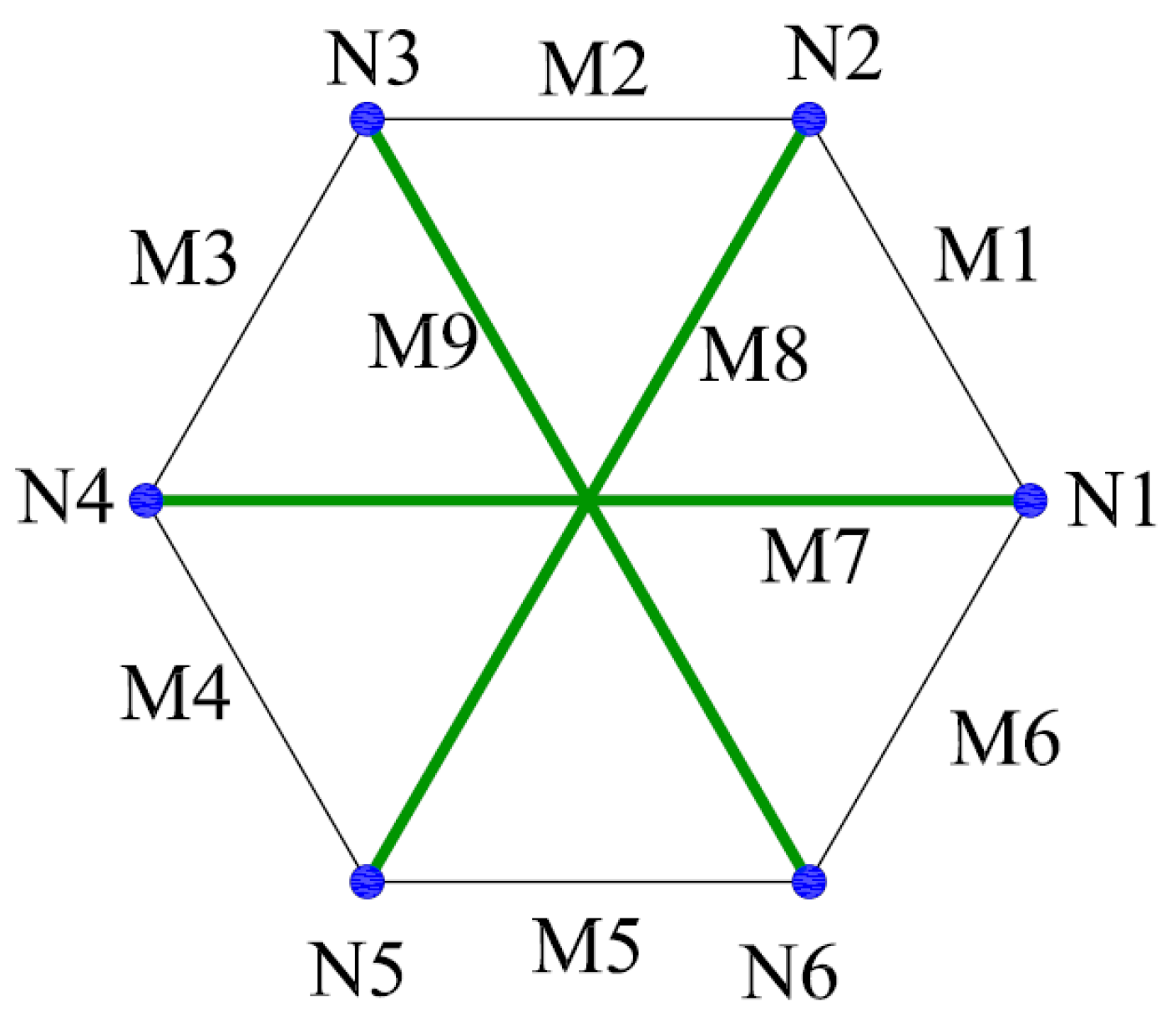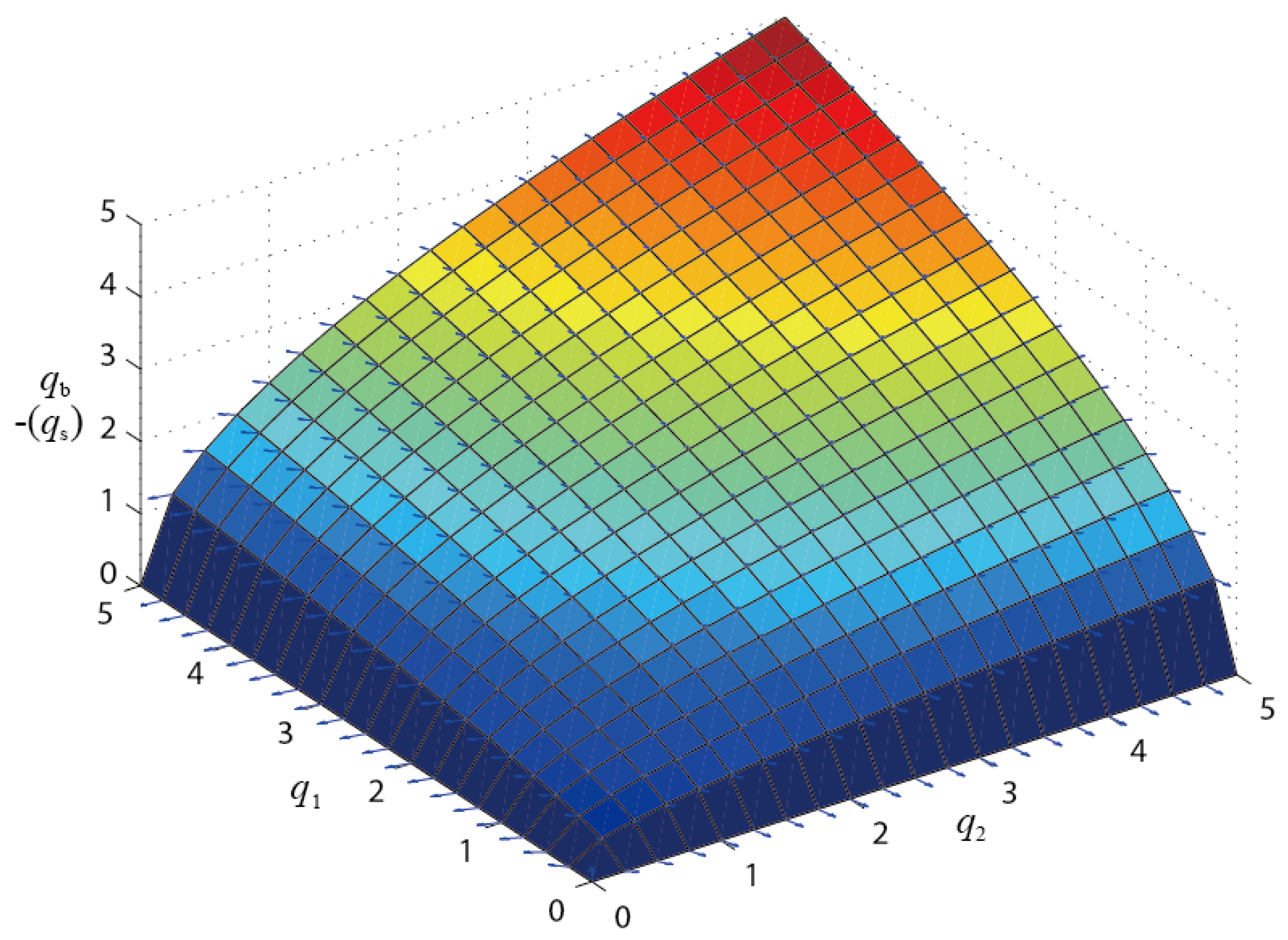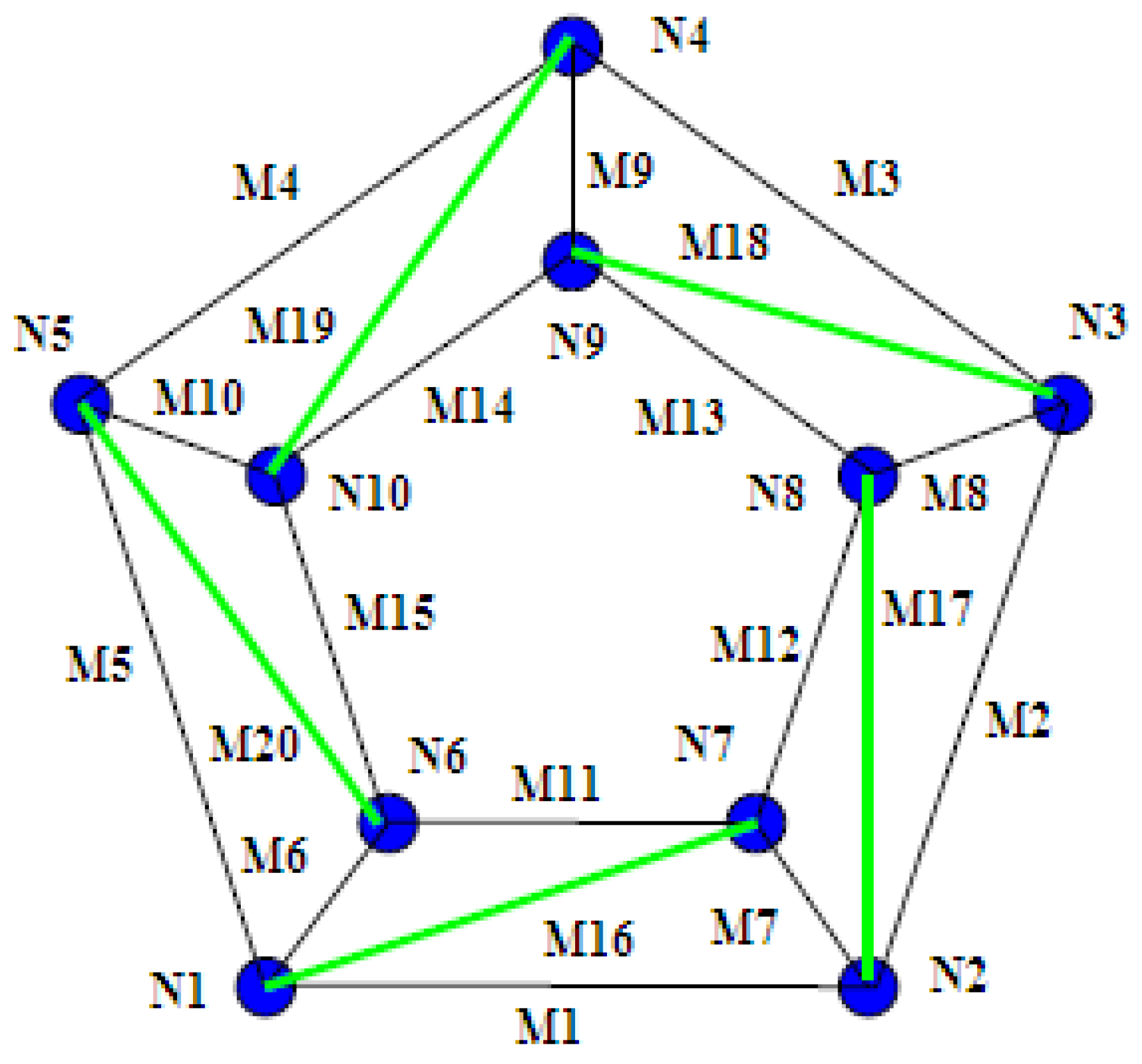Closed-Form Solutions for the Form-Finding of Regular Tensegrity Structures by Group Elements
Abstract
:1. Introduction
2. Force Density Method and Self-Equilibrium Condition
2.1. Assumptions
- (a)
- Members are connected using pin joints;
- (b)
- No external loads are included, and the gravity is ignored;
- (c)
- Member failure is not considered: i.e., struts do not yield and cables do not bear compressive forces;
- (d)
- The structure is self-equilibrated and free-standing without any support;
- (e)
- The topology (connectivity between the nodes and members) of the tensegrity structure is known, and the geometrical configuration of the structure can be described in terms of nodal coordinates only.
2.2. Force Density Method
2.3. Non-Degeneracy Condition
3. Stable Conditions
- (i)
- the geometry matrix is full rank;
- (ii)
- the matrix E has (d+1) nonzero eigenvalues;
- (iii)
- the matrix E is positive semi-definite;
4. Form-Finding Method
4.1. Assumptions
4.2. Equilibrium Analysis
- Step 1: Calculate the rank deficiency h of the force density matrix E (Equation (4)).
- Step 2: Notice the number of expressions that are equal to zero and record it as t1. Usually, there is only one expression of eigenvalue equal to zero after the decomposition. We assume this eigenvalue as λ1.
- Step 3: Find all the expressions of eigenvalues that are definitely greater than zero and denote the number of eigenvalues as t2.
- Step 4: Select a few of the rest expressions of eigenvalues equal to zero. Record the number of expressions that are assumed to zero as t3, and t3 + t1 ≥ h should be satisfied.
- Step 5: Get the relationship between force densities from the equations in Step 4.
4.3. Super-Stability Examination
5. Examples
5.1. Planar Tensegrity
5.2. Three-dimensional prismatic tensegrity structures
5.2.1. Triangular Prism
5.2.2. Quadrangular Prism Tensegrity Structure
5.2.3. Quadrangular Prism Tensegrity Structure
5.3. Star-Shaped Tensegrity Structure
6. Conclusions
Author Contributions
Funding
Acknowledgments
Conflicts of Interest
References
- Veenendaal, D.; Block, P. An overview and comparison of structural form finding methods for general networks. Int. J. Solids Struct. 2012, 49, 3741–3753. [Google Scholar] [CrossRef] [Green Version]
- Ali, N.B.H.; Rhode-Barbarigos, L.; Albi, A.A.P. Design optimization and dynamic analysis of a tensegrity-based footbridge. Eng. Struct. 2010, 32, 3650–3659. [Google Scholar]
- Fu, F. Non-linear static analysis and design of Tensegrity domes. Steel Compos. Struct. 2006, 6, 417–433. [Google Scholar] [CrossRef] [Green Version]
- Li, P.C.; Wu, M.E. Stabilities of cable-stiffened cylindrical single-layer latticed shells. Steel Compos. Struct. 2017, 24, 591–602. [Google Scholar]
- Cai, J.G.; Zhang, Q.; Feng, J.; Lee, S.H. Structural evaluation of a foldable cable-strut structure for kinematic roofs. Steel Compos. Struct. 2018, 29, 669–680. [Google Scholar]
- Tibert, A.G.; Pellegrino, S. Deployable tensegrity reflectors for small satellites. J. Spacecr. Rocket. 2002, 39, 701–709. [Google Scholar] [CrossRef] [Green Version]
- Li, T.; Jiang, J.; Deng, H. Form-finding methods for deployable mesh reflector antennas. Chin. J. Aeronaut. 2013, 26, 1276–1282. [Google Scholar] [CrossRef] [Green Version]
- Ingber, D.E. Tensegrity I: Cell structure and hierarchical systems biology. J. Cell Sci. 2003, 116, 1157–1173. [Google Scholar] [CrossRef] [PubMed] [Green Version]
- Stamenović, D. Effects of cytoskeletal prestress on cell rheological behavior. Acta Biomater. 2005, 1, 255–262. [Google Scholar] [CrossRef] [PubMed]
- Cai, J.G.; Yang, R.G.; Wang, X.Y.; Feng, J. Effect of initial imperfections of struts on the mechanical behavior of tensegrity structures. Compos. Struct. 2019, 207, 871–876. [Google Scholar] [CrossRef]
- Connelly, R.; Back, A. Mathematics and Tensegrity: Group and representation theory make it possible to form a complete catalogue of “strut-cable” constructions with prescribed symmetries. Am. Sci. 1998, 86, 142–151. [Google Scholar] [CrossRef]
- Bliss, T.; Werly, J.; Iwasaki, T. Experimental validation of robust resonance entrainment for cpg-controlled tensegrity structures. IEEE Trans. Control Syst. Technol. 2013, 21, 666–678. [Google Scholar] [CrossRef]
- Li, Y.; Feng, X.Q.; Cao, Y.P. A Monte Carlo form-finding method for large scale regular and irregular tensegrity structures. Int. J. Solids Struct. 2010, 47, 1888–1898. [Google Scholar] [CrossRef] [Green Version]
- Cai, J.; Feng, J. Form-finding of tensegrity structures using an optimization method. Eng. Struct. 2015, 104, 126–132. [Google Scholar] [CrossRef]
- Xu, X.; Wang, Y.; Luo, Y. Finding member connectivities and nodal positions of tensegrity structures based on force density method and mixed integer nonlinear programming. Eng. Struct. 2018, 166, 240–250. [Google Scholar] [CrossRef]
- Schek, H.J. The force density method for form finding and computation of general networks. Comput. Methods Appl. Mech. Eng. 1974, 3, 115–134. [Google Scholar] [CrossRef]
- Aboul-Nasr, G.; Mourad, S.A. An extended force density method for form finding of constrained cable nets. Case Stud. Struct. Eng. 2015, 3, 19–32. [Google Scholar] [CrossRef] [Green Version]
- Zhang, J.Y.; Ohsaki, M. Adaptive force density method for form-finding problem of tensegrity structures. Int. J. Solids Struct. 2006, 43, 5658–5673. [Google Scholar] [CrossRef] [Green Version]
- Zhang, J.Y.; Ohsaki, M.; Kanno, Y. A direct approach to design of geometry and forces of tensegrity systems. Int. J. Solids Struct. 2006, 43, 2260–2278. [Google Scholar] [CrossRef] [Green Version]
- Sánchez, J.; Serna, M.Á.; Morer, P.A. Multi-step force–density method and surface-fitting approach for the preliminary shape design of tensile structures. Eng. Struct. 2007, 29, 1966–1976. [Google Scholar] [CrossRef]
- Tran, H.C.; Lee, J. Advanced form-finding of tensegrity structures. Comput. Struct. 2010, 88, 237–246. [Google Scholar] [CrossRef]
- Feng, X.; Guo, S. A novel method of determining the sole configuration of tensegrity structures. Mech. Res. Commun. 2015, 69, 66–78. [Google Scholar] [CrossRef]
- Motro, R.; Najari, S.; Jouanna, P. Shell and Spatial Structures: Computational Aspects; Lecture Notes in Engineering 26; Springer: Berlin, Germany, 1987. [Google Scholar]
- Zhang, L.; Maurin, B.; Motro, R. Form-Finding of Nonregular Tensegrity Systems. J. Struct. Eng. 2006, 132, 1435–1440. [Google Scholar] [CrossRef]
- Pagitz, M.; Tur, J.M.M. Finite element based form-finding algorithm for tensegrity structures. Int. J. Solids Struct. 2009, 46, 3235–3240. [Google Scholar] [CrossRef]
- Ohsaki, M.; Zhang, J.Y. Nonlinear programming approach to form-finding and folding analysis of tensegrity structures using fictitious material properties. Int. J. Solids Struct. 2015, 69–70, 1–10. [Google Scholar] [CrossRef]
- Pellegrino, S.; Tibert, A.G. Review of Form-Finding Methods for Tensegrity Structures. Int. J. Space Struct. 2003, 18, 209–223. [Google Scholar]
- Juan, S.H.; Tur, J.M.M. Tensegrity frameworks: Static analysis review. Mech. Mach. Theory 2008, 43, 859–881. [Google Scholar] [CrossRef] [Green Version]
- Motro, R. Tensegrity: Structural Systems for the Future; Elsevier: San Diego, CA, USA, 2003. [Google Scholar]
- Koohestani, K.; Guest, S.D. A new approach to the analytical and numerical form-finding of tensegrity structures. Int. J. Solids Struct. 2013, 50, 2995–3007. [Google Scholar] [CrossRef] [Green Version]
- Connelly, R.; Terrell, M. Globally rigid Symmetric Tensegrities. Struct. Topol. 1995, 21, 59–78. [Google Scholar]
- Crane, C.D.; Duffy, J.; Correa, J.C. Static Analysis of Tensegrity Structures. J. Mech. Des. 2005, 127, 257–268. [Google Scholar] [CrossRef] [Green Version]
- Murakami, H.; Nishimura, Y. Static and dynamic characterization of regular truncated icosahedral and dodecahedral tensegrity modules. Int. J. Solids Struct. 2001, 38, 9359–9381. [Google Scholar] [CrossRef]
- Raj, R.P.; Guest, S.D. Using Symmetry for Tensegrity Form-Finding. J. Int. Assoc. Shell Spat. Struct. 2006, 47, 245–252. [Google Scholar]
- Zhang, J.Y.; Guest, S.D.; Ohsaki, M. Symmetric prismatic tensegrity structures: Part I. Configuration and stability. Int. J. Solids Struct. 2009, 46, 1–14. [Google Scholar] [CrossRef] [Green Version]
- Zhang, J.Y.; Guest, S.D.; Ohsaki, M. Symmetric prismatic tensegrity structures. Part II: Symmetry-adapted formulations. Int. J. Solids Struct. 2009, 46, 15–30. [Google Scholar] [CrossRef] [Green Version]
- Zhang, J.Y.; Ohsaki, M. Self-equilibrium and stability of regular truncated tetrahedral tensegrity structures. J. Mech. Phys. Solids 2012, 60, 1757–1770. [Google Scholar] [CrossRef]
- Zhang, L.Y.; Li, Y.; Cao, Y.P. Self-equilibrium and super-stability of truncated regular polyhedral tensegrity structures: A unified analytical solution. Proc. R. Soc. A 2012, 468, 3323–3347. [Google Scholar] [CrossRef] [Green Version]
- Zhang, L.Y.; Li, Y.; Cao, Y.P. A unified solution for self-equilibrium and super-stability of rhombic truncated regular polyhedral tensegrities. Int. J. Solids Struct. 2013, 50, 234–245. [Google Scholar] [CrossRef] [Green Version]
- Zhang, L.Y.; Zhu, S.X.; Li, S.X.; Xu, G.K. Analytical form-finding of tensegrities using determinant of force-density matrix. Compos. Struct. 2018, 189, 87–98. [Google Scholar] [CrossRef]
- Estrada, G.G.; Bungartz, H.J.; Mohrdieck, C. Numerical form-finding of 2D tensegrity structures. Int. J. Solids Struct. 2006, 43, 6855–6868. [Google Scholar] [CrossRef] [Green Version]
- Masic, M.; Skelton, R.E.; Gill, P.E. Algebraic tensegrity form-finding. Int. J. Solids Struct. 2005, 42, 4833–4858. [Google Scholar] [CrossRef]
- Burkhardt, R.; Solutions, T. The Application of Nonlinear Programming to the Design and Validation of Tensegrity Structures with Special Attention to Skew Prisms. J. -Int. Assoc. Shell Spat. Struct. 2006, 150, 3. [Google Scholar]
- Connelly, R. Rigidity and energy. Invent. Math. 1982, 66, 11–33. [Google Scholar] [CrossRef]
- Micheletti, A.; Williams, W.O. A marching procedure for form-finding for tensegrity structures. J. Mech. Mater. Struct. 2007, 2, 857–882. [Google Scholar] [CrossRef] [Green Version]
- Xu, X.; Luo, Y. Form-finding of nonregular tensegrities using a genetic algorithm. Mech. Res. Commun. 2010, 37, 85–91. [Google Scholar] [CrossRef]
- Yamamoto, M.; Gan, B.S.; Fujita, K.A. Genetic Algorithm Based Form-Finding for Tensegrity Structure. Procedia Eng. 2011, 14, 2949–2956. [Google Scholar] [CrossRef] [Green Version]
- Koohestani, K. Form-finding of tensegrity structures via genetic algorithm. Int. J. Solids Struct. 2012, 49, 739–747. [Google Scholar] [CrossRef] [Green Version]
- Seunghye, L.; Buntara, S.G.; Jaehong, L. A fully automatic group selection for form-finding process of truncated tetrahedral tensegrity structures via a double-loop genetic algorithm. Compos. Part B Eng. 2016, 106, 308–315. [Google Scholar]
- Maxwell, J.C. On the calculation of the equilibrium and stiffness of frames. Philos. Mag. 1864, 27, 294–299. [Google Scholar] [CrossRef]
- Calladine, C.R. Buckminster Fullews “tensegrity” structures and Clerk Maxwell’s rules for the construction of stiff frames. Int. J. Solids Struct. 1978, 14, 161–172. [Google Scholar] [CrossRef]
- Deng, H.; Kwan, A. Unified classification of stability of pin-jointed bar assemblies. Int. J. Solids Struct. 2005, 42, 4393–4413. [Google Scholar] [CrossRef]
- Guest, S. The stiffness of prestressed frameworks: A unifying approach. Int. J. Solids Struct. 2006, 43, 842–854. [Google Scholar] [CrossRef] [Green Version]
- Zhang, J.Y.; Ohsaki, M. Stability conditions for tensegrity structures. Int. J. Solids Struct. 2007, 44, 3875–3886. [Google Scholar] [CrossRef] [Green Version]
- Chen, Y.; Feng, J.; Sun, Q.Z. Lower-order symmetric mechanism modes and bifurcation behavior of deployable bar structures with cyclic symmetry. Int. J. Solids Struct. 2018, 139–140, 1–14. [Google Scholar] [CrossRef]
- Chen, Y.; Sareh, P.; Feng, J.; Sun, Q.Z. A computational method for automated detection of engineering structures with cyclic symmetries. Comput. Struct. 2017, 191, 153–164. [Google Scholar] [CrossRef]
- Zhang, J.Y.; Ohsaki, M. Tensegrity Structures: Form, Stability, and Symmetry; Mathematics for Industry 6; Springer: Berlin, Germany, 2016. [Google Scholar]
- Estrada, G.G. Analytical and Numerical Investigations of Form-finding Methods for Tensegrity Structures. Ph.D. Thesis, University of Stuttgart, Stuttgart, Germany, 2007. [Google Scholar]










© 2020 by the authors. Licensee MDPI, Basel, Switzerland. This article is an open access article distributed under the terms and conditions of the Creative Commons Attribution (CC BY) license (http://creativecommons.org/licenses/by/4.0/).
Share and Cite
Zhang, Q.; Wang, X.; Cai, J.; Zhang, J.; Feng, J. Closed-Form Solutions for the Form-Finding of Regular Tensegrity Structures by Group Elements. Symmetry 2020, 12, 374. https://doi.org/10.3390/sym12030374
Zhang Q, Wang X, Cai J, Zhang J, Feng J. Closed-Form Solutions for the Form-Finding of Regular Tensegrity Structures by Group Elements. Symmetry. 2020; 12(3):374. https://doi.org/10.3390/sym12030374
Chicago/Turabian StyleZhang, Qian, Xinyu Wang, Jianguo Cai, Jingyao Zhang, and Jian Feng. 2020. "Closed-Form Solutions for the Form-Finding of Regular Tensegrity Structures by Group Elements" Symmetry 12, no. 3: 374. https://doi.org/10.3390/sym12030374





